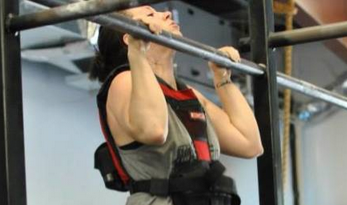Is anyone participating in The Murph Challenge on Memorial Day?
1-mile run
100 pull-ups
200 pushups
300 squats
1-mile run
....with body armor or 20lb weight vest
I've been doing it since 2016.
My current training schedule:
Mon: BuiltStrong Minimalist (H: Double Kettlebell Presses, M: Bulgarian Split Squats, L: 1-Arm Rows)
Tues: Murph training (easy 1/2 - 1-mile run and low-volume Murph: 2/4/6 EMOM for 12-20 minutes)
Wed: BuiltStrong Minimalist (H: DKFS, M: Chin-ups, L: Dips)
Thurs: Off
Fri: BuiltStrong Minimalist (H: Weighted Pull-ups, M: DB Bench Presses, L: Goblet Squats)
Sat: High-volume Murph training (see below)
Sun: Off
The Murph Challenge is only 6 weeks away, and my training is now in high gear!
Today was a 3/4 Murph (75 pull-ups, 150 pushups, 225 squats) in just under 22 minutes without the run.
This is my best time in a few years but still not as good as 2017-2018 when I could complete the 100 pull-ups, 200 pushups, and 300 squats in 19:30 and the entire Murph with body armor in 38-44 minutes.
How do I do it?
With Russian LADDERS!
RUNG 1:
Pull-ups x 1
Pushups x 2
Squats x 3
RUNG 2:
Pull-ups x 2
Pushups x 4
Squats x 6
RUNG 3:
Pull-ups x 3
Pushups x 6
Squats x 9
RUNG 4:
Pull-ups x 4
Pushups x 8
Squats x 12
That's ONE Ladder!
Complete 10 Ladders for a full Murph (without the one-mile run before and after).
I performed 7 Ladders plus an additional rung of 2/4/6 and 3/6/9 to hit 75 pull-ups, 150 pushups, and 225 squats.
I have found it to be the quickest and most efficient way to complete The Murph Challenge.
I've also performed 3/6/9 EMOM for 33 rounds plus one round of 1/2/3 to complete it in 33-34 minutes.
Here's a video I made a couple years ago showing proper form and other options:
1-mile run
100 pull-ups
200 pushups
300 squats
1-mile run
....with body armor or 20lb weight vest
I've been doing it since 2016.
My current training schedule:
Mon: BuiltStrong Minimalist (H: Double Kettlebell Presses, M: Bulgarian Split Squats, L: 1-Arm Rows)
Tues: Murph training (easy 1/2 - 1-mile run and low-volume Murph: 2/4/6 EMOM for 12-20 minutes)
Wed: BuiltStrong Minimalist (H: DKFS, M: Chin-ups, L: Dips)
Thurs: Off
Fri: BuiltStrong Minimalist (H: Weighted Pull-ups, M: DB Bench Presses, L: Goblet Squats)
Sat: High-volume Murph training (see below)
Sun: Off
The Murph Challenge is only 6 weeks away, and my training is now in high gear!
Today was a 3/4 Murph (75 pull-ups, 150 pushups, 225 squats) in just under 22 minutes without the run.
This is my best time in a few years but still not as good as 2017-2018 when I could complete the 100 pull-ups, 200 pushups, and 300 squats in 19:30 and the entire Murph with body armor in 38-44 minutes.
How do I do it?
With Russian LADDERS!
RUNG 1:
Pull-ups x 1
Pushups x 2
Squats x 3
RUNG 2:
Pull-ups x 2
Pushups x 4
Squats x 6
RUNG 3:
Pull-ups x 3
Pushups x 6
Squats x 9
RUNG 4:
Pull-ups x 4
Pushups x 8
Squats x 12
That's ONE Ladder!
Complete 10 Ladders for a full Murph (without the one-mile run before and after).
I performed 7 Ladders plus an additional rung of 2/4/6 and 3/6/9 to hit 75 pull-ups, 150 pushups, and 225 squats.
I have found it to be the quickest and most efficient way to complete The Murph Challenge.
I've also performed 3/6/9 EMOM for 33 rounds plus one round of 1/2/3 to complete it in 33-34 minutes.
Here's a video I made a couple years ago showing proper form and other options:
Last edited:


